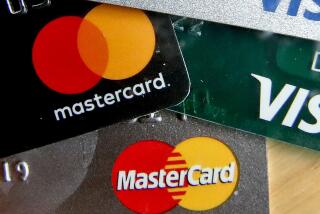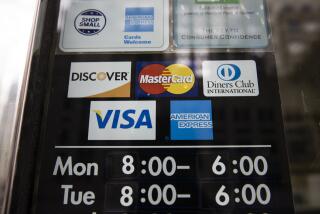Bank Cards Raise Stakes to Lure Users
- Share via
Spending has never been such fun. Borrowing the money to spend is even better.
One could get a hot air balloon ride just for putting $2,500 worth of charges on a Wells Fargo bank card over four months last year, or a compact disc player for running up $12,000 with Citibank in six months. Chase Manhattan charges are rewarded with TWA frequent-flier miles.
Pick a card. Rent a car; they’ll cover the collision damage waiver. Buy a TV; they’ll double the product warranty.
The fun and games encourage spending, of course, and maybe unwise or impulsive spending. They also discourage any changes in the basic terms of the cards. “Instead of competing with lower interest rates,” says Ken McEldowney, executive director of Consumer Action in San Francisco, “they surround their cards with so many gimmicks, you can’t see the rate.”
Some of the “enhancements” are services integral to card use--customer aids such as 24-hour phone lines, lost card replacement, emergency credit extensions. Some are related but peripheral--the 90-day loss and damage insurance on charged merchandise, for example, or warranty extensions. But many, particularly the free gift programs, are simply seductions--not “benefits” but enticements to buy--that tart up the whole transaction.
It is necessary, says current wisdom, because the market is “saturated.” Card issuers have passed out cards so aggressively that consumers are overloaded. Three bank cards apiece is only average.
Therefore, issuers are desperate to “differentiate their product” with a “menu” of enhancements so that consumers will want not only to own that card but to use it and to “give our card preference in their usage hierarchy,” says Rich Srednicki, Citibank’s vice president directing marketing of bank cards. “When they make a purchase, we want them to use our card.”
The intensity is new, not the principle. Ten years ago, Citibank started CitiDollars, a point system allowing cardholders to buy merchandise at prices somewhat lower than the highest retail. Soon everyone was pushing shopping catalogues, emergency road service, travel discounts, even sweepstakes.
A recent rage was “affinity” groups--bank cards with special logos that give the featured organization a small share of the cardholder’s annual fee or a percent of charge volume or even a percent of any outstanding balance.
Appeal Hard to Measure
Some enhancements are of indisputable value to the consumer, making card use simpler, more efficient and problem-free. “People want someone who gets on their side,” says Citibank spokesman William Ahearn, “someone they can ask to ‘work it out for me.’ ”
Twenty-four-hour phone lines (first offered by Citibank in 1985) are common, with variations: Chase Manhattan touts its automation (push-button balances); Wells Fargo proudly guarantees a human voice. Service representatives can grant credit extensions, report and replace lost cards and resolve disputes on purchases and payments or begin investigations.
Some enhancements are only potentially serviceable. It is hard to measure the appeal of the insurance and warranty coverages pioneered by American Express and now offered on most premium and some standard bank cards.
The only available indications of consumer interest date from the first offers, when the product coverages required an onerous process of registration within 30 days of purchase, including proofs of purchase, serial numbers, descriptions, etc. No wonder only 30,000, or 0.8%, of Chase Manhattan’s 3.5 million cardholders signed up for either.
Even more difficult to measure is usage. Card issuers won’t discuss claims, fearful either of encouraging greater use or of revealing lack of use. Usage may not even be an important measure of value. The attraction, “as with any kind of emergency service,” says David Robertson, vice president of the Nilson Report, a Santa Monica-based newsletter for the credit card industry, “is that you have it available.”
The latest and hottest seduction (as opposed to service) is old stuff, going back to box tops and Blue Chip stamps. Many bank cards now offer premium gifts, a “benefit” not related to what one bought or how one paid, but simply to how much one spent.
They draw as mixed a reaction as the old discount merchandise catalogues, loved by some, hated by others for the over-priced goods, the time-consuming selection, the difficulty of return. Some people hate the premiums on principle for spurring consumption and perhaps greater debt. Some are indifferent, not interested, says a Los Angeles woman, “in accumulating points or figuring out deals or even getting something for nothing. I use my card just for convenience.”
And some like premiums, often taking a “why not?” posture. “We were buying things anyway,” says a Los Angeles man, who got a VCR last year with $18,000 in Citibank charges. “Why not use the card that’ll give me something? It’s free.”
Clearly the enhancement programs work. They do attract more cardholders. When Visa added many free emergency, insurance and travel benefits to its premium card last year in an effort to compete with American Express’ almost unbeatable roster of enhancements, it increased its cardholders from 5 million to 12 million.
Enhancements also increase usage. One banker says the premium programs alone can double usage for the given period. On the record, bank card executives admit to “substantially” increased usage that “stayed at a high level at least six months after the promotion,” says Mike Sczuka, Wells Fargo executive vice president in charge of credit cards.
Even when it declines, says Citibank’s Srednicki, “it stays above where it would have been had we not run the promotion. We got them used to taking out our card.”
Given the competition, promotion must follow promotion. “Like any consumer product, you have to keep promoting,” says Sczuka.
But the flashy promotions can’t go on forever; even the most compulsive spenders get bored with a particular game. And when they stop, all the true benefits, the anti-hassle customer services, will probably remain, which is good for the cardholders. It is good too for the smart card issuers who have seized the chance to impress customers with the services while holding them with promotions.
More to Read
Inside the business of entertainment
The Wide Shot brings you news, analysis and insights on everything from streaming wars to production — and what it all means for the future.
You may occasionally receive promotional content from the Los Angeles Times.










